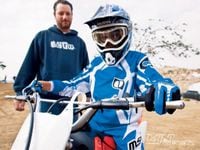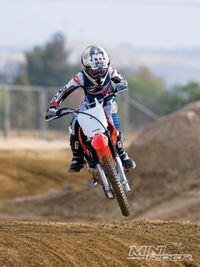At some point in your motorcycling career, you're going to have to learn how to use a clutch. This will allow you to stop, start, shift gears and ride the kind of motorcycles you want to ride. Sure, the 50cc automatic bikes are fine and fun, or your dad's midsize pitbike with a three-speed automatic transmission is getting the job done, but moving up to a clutch bike opens up the door to riding any and every kind of motorcycle and makes doing things later on in life, like driving a stick shift, easier. And for you parents reading this, the clutch is the stepping stone to better manual dexterity, as explained in the sidebar for Mom and Dad's lesson on proper teaching techniques.To help explain the basics of the clutch, we used Honda's CRF80F as our clutch bike. This is a very friendly machine and just a small step up in size from the CRF70F, which has a three-speed automatic-clutched transmission.How It Works
The clutch is like an on/off switch for the power in your engine. It's controlled by the lever on the left side of the handlebar that pulls a cable (or pumps fluid in a hydraulic system) that activates the clutch inside the motor. The clutch is comprised of spinning disks inside a basket that grip each other when you let go of the lever. What a clutch does is transfers and controls the power the motor produces and delivers it into the transmission. You can look at it like a tire. When the clutch is "engaged," or connected, it's like the tire is running on good, smooth pavement. All of the tire's power is getting put on the ground. When you disengage the clutch, it's like lifting the tire off the ground and holding it in the air; it just spins and nothing happens. But when you go to engage the clutch, you want to do it smoothly, because if you "drop it," or release it too quickly, like dropping the spinning tire on the ground, bad things will happen. The tire will either take off abruptly or it will suddenly stop. The same thing happens when you drop the clutch on your motorcycle; the bike will jump forward or it will stall out.Two Digits
Learning to use the clutch can be really easy if you take a couple of small steps. It's best to practice this in a big dirt area where there's nothing to hit and plenty of space to ride around without having to stop. To begin with, learn to hold the lever with your middle and index fingers. This may seem tricky at first, but it will allow your other two fingers to hang onto the handlebar, which will help you to hold on during rough riding. All the top pros use one or two fingers for a reason-it's the best way to use the clutch! Practice moving the lever without the bike running to get a feel for operating the clutch once you're actually riding.Feel The Power
The next step is to learn the "engagement point" of the clutch. This is where it starts to hook up and the bike wants to move. You want to feel where this happens and learn to move the lever really slowly there, so you don't drop the clutch. At the same time, you will be giving the bike a little more gas when the clutch begins to engage, so the motor doesn't stall. The best way to learn this is to start the bike up. Then, without giving the bike any gas and when the bike is in first gear, slowly let out the clutch lever until the motor begins to slow down but the bike still isn't moving. Get a feel for where this engagement point is and learn to control the lever movement, so you can bog the motor a little and then pull in the lever to let it idle back to normal. When doing this, you don't even move, and you also don't want to stall the motor. If it's difficult to operate the clutch in this way, you might want to adjust the lever so that it isn't a stretch for your fingers (you also don't want the lever bumping up against your two smaller fingers on the bar).
Even little guys can rip on clutched-size bikes. Robbie Wageman can't touch the ground, but he can handle the little lever on the left-hand side of the bar just fine. Adjustment of the lever is critical for small-handed riders.
Engage!
Now that you have a feel for the engagement point, the next step is to engage and disengage the clutch. This time let the clutch get to the engagement point and then give the throttle a little twist while you slowly keep letting out the clutch. Then the bike starts to go! Right away you should pull the clutch back in and stop! Yes, you have to pull the clutch back in to stop, and this is something you should be practicing right from the start. So you start, then stop, only going a few feet every time you practice letting the clutch out then pulling it back in. Sometimes you might stall and other times the bike might lunge forward and keep going, but remember to pull the clutch back in and stop the bike with the brakes.Grabbing Gears
It may seem like a lot of work, but it gets really easy quickly. After you have the stopping and starting down, then you can learn to shift. This is really simple, especially if you have shifted your automatic bike before. All you have to do is let off on the throttle, pull in the clutch lever, shift with your foot and then let the clutch right back out. The clutch makes the shift really smooth. You can actually shift without the clutch, but the bike will lunge, slow down harshly and possibly grind in the transmission, so it's best to use it every time. You can also use it on both upshifts and downshifts. But remember, you have to pull in the clutch every time to stop!Practice Makes Perfect
As you get better with the clutch, you will learn to slip it-that is, quickly pull the lever partway in and release it smoothly-to give the bike a boost of power. Sometimes you even slip it when the bike has too much power to keep from doing a wheelie. Most of the time you will ride around and never even touch the clutch, but when you have to, you will know what to do-just don't always be slipping the clutch, because it will wear out. It's best to let it all the way out and control the power with the throttle.Now that you know the secrets to riding with the clutch, it only takes time and a lot of practice to get really good at using it. Knowing how to control your bike's power with the clutch will make you a way better rider, too, so start practicing and have fun honing those newfound skills!Minibike Mom and Dad's Guide to Proper Teaching:
Five Rules You Need to Know
1. Motorcycles are fun. If learning how to handle the clutch is getting difficult, forget about it for a while.2. It's best to keep the old automatic-clutched bike around for a backup if things don't go so well at first. Don't worry, Junior will really want to ride that new bike at some point, but a clutch can be a scary thing at first.3. Your kid's dexterity isn't like yours. Remember when you were a kid? I didn't think so. It takes more time and practice for a kid to get it figured out than you can comprehend now, but as soon as they get it handled, they will catch on quickly.4. Read and remember the steps in this article-they really work! Junior is going to be so excited, he or she may forget some things, and that's where being an educated adult comes into play.5. Sometimes it can be best to have someone else besides Mom and Dad to teach. Look for the most patient and calm person you can find. And always remember rule #1!My First Ride On A Clutch Bike
By Sean Scudellari
Age: 11
Riding since: 2007"When I first thought about riding a bigger bike with a clutch, I was nervous. It was very hard at first, but after a couple more tries, it got easier. I liked the clutch after I got good with it. Some of the things I like about the CRF80 that I got to ride was that it had better suspension, it was a lot faster and it was easier for me to ride than my CRF70. I'm glad I learned to use the clutch, because I got to ride a better bike. After I learned to ride the 80, I was on it for the rest of the day!"


/cloudfront-us-east-1.images.arcpublishing.com/octane/3T32INAZQRGPXOGGA36NQJDSSM.jpg)
/cloudfront-us-east-1.images.arcpublishing.com/octane/EPLS5PBKXBHNXK7S5O7G4ND3YQ.jpg)
/cloudfront-us-east-1.images.arcpublishing.com/octane/MNGOZAGZFZBH5DPFV7NOPF5S3Y.jpg)
/cloudfront-us-east-1.images.arcpublishing.com/octane/VGJWIIFM2VBCXG34KRQ37GCP7U.jpg)
/cloudfront-us-east-1.images.arcpublishing.com/octane/2ZU3HXRPMZESJF7HDLZJV7FHEY.jpg)
/cloudfront-us-east-1.images.arcpublishing.com/octane/VVFWQBZEIZDVJHZIW5ISKWKOZU.jpg)
/cloudfront-us-east-1.images.arcpublishing.com/octane/7T7FZXHIIBDX7AOBD5S3IICUJI.jpg)
/cloudfront-us-east-1.images.arcpublishing.com/octane/T3Y7A52TXBEBJNEPGOQSVPQSPU.jpg)
/cloudfront-us-east-1.images.arcpublishing.com/octane/KY33U3WBTNFIBJFMTEF2SM7BOQ.jpg)
/cloudfront-us-east-1.images.arcpublishing.com/octane/JNPS5MGVXJC7BARVMARYQIQHXE.jpg)
/cloudfront-us-east-1.images.arcpublishing.com/octane/63N2P6SYAZDURJDO5KARQYX2J4.jpg)
/cloudfront-us-east-1.images.arcpublishing.com/octane/C72WX35SXFETTO5OVA2RWT523I.jpg)
/cloudfront-us-east-1.images.arcpublishing.com/octane/F3ER37EV2RGY5CRYFNTWE3JSF4.jpg)
/cloudfront-us-east-1.images.arcpublishing.com/octane/L65QCUR32RH2NKCUHXYHHAPDFI.jpg)
/cloudfront-us-east-1.images.arcpublishing.com/octane/VSK246VVRRDMBNQU7B2NTNY6AE.jpg)
/cloudfront-us-east-1.images.arcpublishing.com/octane/CG64RRFAYRENNAP2AA22T2LSJY.jpg)
/cloudfront-us-east-1.images.arcpublishing.com/octane/IKZSRLBWMRDORMORBXSISL4D6M.jpg)
/cloudfront-us-east-1.images.arcpublishing.com/octane/BJLVRPJSDFC3ZLPMW3LYYHMPZE.jpg)
/cloudfront-us-east-1.images.arcpublishing.com/octane/RQW2RFU4MJDYRPVFJNW362SEXU.jpg)
/cloudfront-us-east-1.images.arcpublishing.com/octane/CGQDU7HEEBBWBLF6SMXCJIW7DI.jpg)
/cloudfront-us-east-1.images.arcpublishing.com/octane/B35XXACE4ZGU5BWSEMEFUL6SN4.jpg)
/cloudfront-us-east-1.images.arcpublishing.com/octane/TDSGY4VSSRC4LP6PYXP62U236Y.jpg)
/cloudfront-us-east-1.images.arcpublishing.com/octane/4YWNAG64EZF63AQI3VL7ANERSY.jpg)
/cloudfront-us-east-1.images.arcpublishing.com/octane/QFQQG7ZZKFB5VC7C7B5PTOCJ2E.jpg)